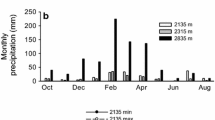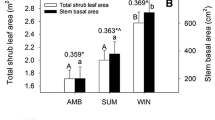Summary
Water and nitrogen regimes of Larrea tridentata shrubs growing in the field were manipulated during an annual cycle. Patterns of leaf water status, leaf water relations characteristics, and stomatal behavior were followed concurrently. Large variations in leaf water status in both irrigated and nonirrigated individuals were observed. Predawn and midday leaf water potentials of nonirrigated shrubs were lowest except when measurements had been preceded by significant rainfall. Despite the large seasonal variation in leaf water status, reasonably constant, high levels of turgor were maintained. Pressure-volume curve analysis suggested that changes in the bulk leaf osmotic potential at full turgor were small and that nearly all of the turgor adjustment was due to tissue elastic adjustment. The increase in tissue elasticity with increasing water deficit manifested itself as a decrease in the relative water content at zero turgor and as a decrease in the tissue bulk elastic modulus. Because of large hydration-induced displacement in the osmotic potential and relative water content at zero turgor, it was necessary to use shoots in their natural state of hydration for pressure-volume curve determinations. Large diurnal and seasonal differences in maximum stomatal conductance were observed, but could not easily be attributed to variations in leaf water potential or leaf water relations characteristics such as the turgor loss point. The single factor which seemed to account for most of the diurnal and seasonal differences in maximum stomatal conductance between individual shrubs was an index of soil/root/ shoot hydraulic resistance. Daily maximum stomatal conductance was found to decrease with increasing soil/root/ shoot hydraulic resistance. This pattern was most consistent if the hydraulic resistance calculation was based on an estimate of total canopy transpiration rather than the more commonly used transpiration per unit leaf area. The reasons for this are discussed. It is suggested that while stomatal aperture necessarily represents a major physical resistance controlling transpiration, plant hydraulic resistance may represent the functional resistance through its effects on stomatal aperture.
Similar content being viewed by others
References
Bates LM, Hall AE (1981) Stomatal closure with soil water depletion not associated with changes in bulk leaf water status. Oecologia (Berlin) 50:62–65
Cutler JM, Shahan KW, Steponkus PL (1980) Alteration of internal water relations of rice in response to drought hardening. Crop Science 20:307–310
Davies FS, Lakso AN (1979) Diurnal and seasonal changes in leaf water potential components and elastic properties in response to water stress in apple trees. Physiol Plant 46:109–114
Goldstein GH, Rada F, Catalan A (1987) Water transport efficiency in stems of evergreen and deciduous savanna trees. In: Proceedings of international conference on measurement of soil and plant water status, vol 2. Utah State Univ., Logan Utah, pp 267–274
Gollan T, Turner NC, Schulze E-D (1985) The responses of stomata and leaf gas exchanges to vapor pressure deficits and soil water content. III. In the sclerophyllous woody species Nerium oleander. Oecologia 65:356–362
Hinckley TM, Duhme F, Hinckley AR, Richter H (1980) Water relations of drought hardy shrubs: Osmotic potential and stomatal reactivity. Plant Cell Environ 3:131–140
Hinckley TM, Duhme F, Hinckley AR, Ritcher H (1983) Drought relations of shrub species; assessment of the mechanisms of drought resistance. Oecologia (Berlin) 59:344–350
Jarvis PG (1985) Coupling of transpiration to the atmosphere in horticultural crops: The omega factor. Acta Horticulturae 171:187–205
Jarvis PG, McNaughton KG (1986) Stomatal control of transpiration: Scaling up from leaf to region. Adv Ecol Res 15:1–49
Kappen L, Oertli JJ, Lange OL, Schulze E-D, Evenari M, Buchsbom U (1975) Seasonal and diurnal cources of water relations of the arido-active plant Hammada scoparia in the Negev Desert. Oecologia 21:175–192
Kikuta SB, Richter H (1986) Graphical evaluation and partitioning of turgor responses to drought in leaves of durum wheat. Planta 168:36–42
Kuppers M (1984) Carbon relations and competition between woody species in a Central European hedgerow. II. Stomatal responses, water use and hydraulic conductivity in the root/leaf pathway. Oecologia 64:344–354
Meinzer FC, Rundel PW, Sharifi MR, Nilsen ET (1986) Turgor and osmotic relations of the desert shrub Larrea tridentata. Plant Cell Environ 9:467–475
Melkonian JJ, Wolfe J, Steponkus PL (1982) Determination of the volumetric modulus of elasticity of wheat leaves by pressure-volume relations and the effect of drought conditioning. Crop Science 22:117–123
Monson RK, Smith SD (1982) Seasonal water potential components of Sonoran Desert plants. Ecology 63:113–123
Nilsen ET, Sharifi MR, Rundel PW (1984) Comparative water relations of phreatophytes in the Sonoran Desert of California. Ecology 65:767–778
Nilsen ET, Sharifi MR, Rundel PW, Jarrell WM, Virginia RA (1983) Diurnal and seasonal water relations of the phreatophyte Prosopis glandulosa (honey mesquite) in the Sonoran Desert of California. Ecology 64:1381–1393
Odening WR, Strain BR, Oechel WC (1974) The effect, of decreasing water potential on net CO2 exchange of intact desert shrubs. Ecology 55:1086–1095
Oechel WC, Strain BR, Odening WR (1972) Tissue water potential, photosynthesis, 14C-labeled photosynthate utilization, and growth in the desert shrub Larrea divaricata Cav. Ecol Monogr 42:127–141
Parker WC, Pallardy SG, Hinckley TM, Teskey RO (1982) Seasonal changes in tissue water relations of three woody species of the Quercus-Carya forest type. Ecology 63:1259–1267
Pavlik BM (1984) Seasonal changes of osmotic pressure, symplasmic water content and tissue elasticity in the blades of dune grasses growing in situ along the coast of Oregon. Plant Cell Environ 7:531–539
Roberts SW, Strain BR, Knoerr KR (1980) Seasonal patterns of leaf water relations in four co-occurring forest tree species: Parameters from pressure-volume curves. Oecologia 46:330–337
Roberts SW, Strain BR, Knoerr KR (1981) Seasonal variation in leaf tissue elasticity in four forest tree species. Physiol Plant 52:245–250
Robichaux RH, Holsinger KE, Morse SR (1986) Turgor maintenance in Hawaiian Dubautia species: The role of variation in tissue osmotic and elastic properties. In: Givnish TJ (ed) On the economy of plant form and function. Cambridge University Press, New York, pp 353–380
Running SW (1976) Environmental control of leaf water conductance in conifers. Can J For Res 6:104–112
Sanchez-Diaz M, Mooney HA (1979) Resistance to water transfer in desert shrubs native to Death Valley, California. Physiol Plant 46:139–146
Scholander PF, Hammel HT, Hemmingsen EA, Bradstreet ED (1964) Hydrostatic pressure and osmotic potential in leaves of mangrove and some other plants. Proc Nat Acad Sciences 51:119–125
Schulze E-D (1986) Carbon dioxide and water vapor exchange in response to drought in the atmosphere and in the soil. Ann Rev Plant Physiol 37:247–274
Sharifi MR, Meinzer FC, Nilsen ET, Rundel PW, Virginia RA, Jarrell WM, Herman DJ (1987) Effect of resource manipulation on the quantitative phenology of Larrea tridentata (creosote bush) in the Sonoran Desert of California. Am J Bot
Sobrado MA (1986) Tissue water relations and leaf growth of tropical corn cultivars under water deficits. Plant Cell Environ 9:451–457
Syvertsen JP (1982) Minimum leaf water potential and stomatal closure in citrus leaves of different ages. Ann Bot 49:827–834
Teskey RO, Hinckley TM, Grier CC (1983) Effect of interruption of flow path on stomatal conductance of Abies amabilis. J Exp Bot 34:1251–1259
Turner NC, Begg JR, Tonnett ML (1967) Osmotic adjustment of sorghum and sunflower crops in response to water deficits and its influence on the water potential at which stomata close. Aust J Plant Physiol 5:597–608
Turner NC, Long MJ (1980) Errors arising from rapid water loss in the measurement of leaf water potential by the pressure chamber technique. Aust J Plant Physiol 7:527–537
Tyree MT (1981) The relationship between the bulk modulus of elasticity of a complex tissue and the mean modulus of its cells. Ann Bot 47:547–554
Tyree MT, Jarvis PG (1982) Water in tissues and cells. In: Lange OL, Nobel PS, Osmond CB, Ziegler H (eds) Encyclopedia of Plant Physiology, New Series, vol 12B, Physiological plant ecology II. Springer-Verlag, New York, pp 35–77
Ullmann I (1985) Tagesgänge von Transpiration und stomatarer Leitfähigkeit Sahelischer und Saharischer Akazien in der Trockenzeit. Flora 176:383–409
Author information
Authors and Affiliations
Rights and permissions
About this article
Cite this article
Meinzer, F.C., Sharifi, M.R., Nilsen, E.T. et al. Effects of manipulation of water and nitrogen regime on the water relations of the desert shrub Larrea tridentata . Oecologia 77, 480–486 (1988). https://doi.org/10.1007/BF00377263
Received:
Issue Date:
DOI: https://doi.org/10.1007/BF00377263




